ERNEST CAMILLERI - MaltaRightNow.com
ERNEST CAMILLERI - MaltaRightNow.com
ERNEST CAMILLERI - MaltaRightNow.com
- No tags were found...
You also want an ePaper? Increase the reach of your titles
YUMPU automatically turns print PDFs into web optimized ePapers that Google loves.
| RADIO |ChartActionEric Montfort on the new vibrant Chartshow on Radio 101Many years ago, it was a joy to tune in to theBBC for the UK Top 20 charts, either by meansof shortwave radio, through Rediffusion - thecable radio supplier - or through BFBS, theBritish Forces radio which closed down in1979. Back then, it was the most followedchart show in the world with around 50 millionlisteners per week.Rediffusion also used to broadcast the US chartsthrough Billboard magazine – which is still today avery authoritative source for the American charts.In the late 1960s and early 1970s, DJs like JohnnyWalker, Paul Burnett, the late Stuart Henry and TommyVance attracted numerous listeners thanks to theBBC or through the programmes that at the time weresyndicated to various radio stations, including BFBS.Things have changed considerably since; moreand more, it’s the impersonal world of internet radio,web-streaming and cable TV – the likes of MTV - thatdetermine what gets played, and with the onset ofdownloading, sales have literally plummeted. Sufficeit to say that sales of just 10,000 copies would beenough to see an artist make the top spot in the UKcharts. In the US, the norm is around 50,000, when 20years ago, it would have required ten times as manysales to make it to the top three. Also gone are thedays where one could enjoy following their favouritesongs make their way up and down in an orderly, attimes surprising fashion, especially in Britain. Now, asong may enter the top spot and the following week,it would make a quick slide out of the top ten, neverto be heard of again. A mixture of airplay and (legal)download surveys, as well as the old formal returnsof records’ sales (albeit in a much diminished form),have lately stabilised this whirlwind trend in the UKsingles’ charts, however, a lot of people have resignedthemselves to the fact that the singles’ charts are notwhat they used to be.It’s safe to say that chart performance today alsodepends on live concerts, with attendances and recordsales during these events contributing greatly to anartist’s in<strong>com</strong>e. Moreover, we have also experienceda trend that has also gained a lotof ground overseas - theemphasis on airplay charts.Many radio stations have takenthe cue from US stations andhave now been <strong>com</strong>piling theirown airplay charts according tolisteners’ wishes.Radio 101 is no exception.Every Sunday, until the end ofsummer, Frank Zammit is hostingThe Chartshow, a programmethat delves into the UK, Italianand American charts, besidesproviding Radio 101’s own airplaycharts. Frank also makes it apoint to include retro-charts too,as great pop music is still popularwith Radio 101’s listeners. Frankalso admits that thecharts were moreintriguing then, withartists succeedingin crossing over todifferent charts, aswas the case withMichael Jacksonwith Dirty Diana20 years ago.“Now, with morefragmentation, itis more difficultto do so. Onthe other hand,hosting theRadio 101 charts alsogives an insight to artists like Peter Mraz who havefound the going quite tough in other charts.” I alsoremember the time when there used to be a Maltesenational chart too, but now, in a thoroughly differentscenario, attempting to revive such a chart is an evenmore difficult task!The Chart Show is on air on Radio 101 at 15.30hours every Sunday.top: dizzee rascallcurrently atnumber one in theUK charts with thesong Dance WivMe in conjunctionwith Harris andChrome.above: presenterFrank Zammit38 L&s | august ’08



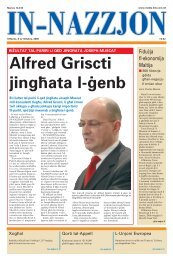

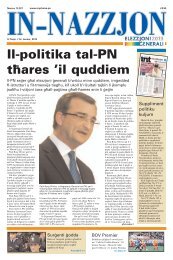
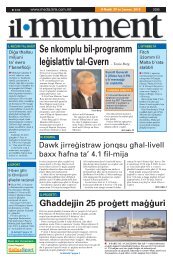
![Sandro Chetcuti akku]at b'attentat ta' qtil - MaltaRightNow.com](https://img.yumpu.com/50098970/1/174x260/sandro-chetcuti-akkuat-battentat-ta-qtil-maltarightnowcom.jpg?quality=85)



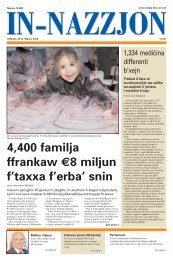


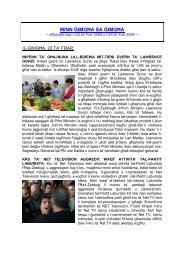

![Malta tibqa' ]]omm mal-po]izzjoni li ddikjarat fis-summit](https://img.yumpu.com/44301444/1/174x260/malta-tibqa-omm-mal-poizzjoni-li-ddikjarat-fis-summit.jpg?quality=85)
